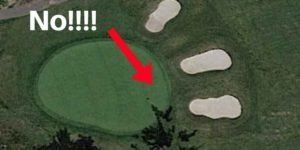
Hitting a green in regulation (GIR) is defined as the following - if any part of your ball is touching the putting surface and the number of strokes taken is at least two fewer than par. This simple definition does not do it justice though. I believe this is the most important statistic for golfers to measure themselves by if they want to shoot their lowest scores.
Stats have become extremely important in the golf world. I believe that they have a place in the recreational golfer's game-improvement plans because they allow you to set measurable goals.
Recently a reader wrote me an email asking how he could hit more greens in regulation. He had done a statistical analysis of his game using GAME GOLF (something I recommend to everyone). His goal is to reach a 5 handicap index, and he believes that improving his GIR is the way to do it. So I am going to try to answer his question with a few thoughts on how all of you can hit more greens in regulation.
If anyone has any questions you are always free to get in touch with me here.
Why Are Greens in Regulation so Important?
There has been a lot of advanced analysis on golf statistics over the last few years. Two great books that I would recommend to learn more are Lowest Score Wins and Every Shot Counts. While the books are not exactly the same, some of the key takeaways are similar.
If you are a golfer who wants to improve, you have to increase your green in regulation number. The process of getting there is a bit more complicated, but it is the truth. When I spoke about what golfers need to do to break 80, it was one of the main focuses of the article.
The reason for this is because your chances of making a par (or better) dramatically increase when your ball is on the putting surface versus being in the rough or a sand trap. Personally, I have made hitting more greens in regulation the focus of my own game, and have been able to increase my percentage from the low 40s to just under 70%. Not surprisingly, my index dropped significantly (I play to a .7 handicap at the current moment).
Make no mistake though, hitting more greens in regulation is a bigger challenge than improving your short game in my most humble of opinions. Let's discuss a few ways that I think you can make it happen.
Tee Shots - Setting Yourself up for a GIR
Your performance off the tee on a par 4 or par 5 is crucially important to increasing your GIR. Hitting tee shots that put you in position to score is your main goal. It is mainly a function of your distance and dispersion.
Generally speaking, the farther you hit the ball off the tee, the greater your chances of hitting a green in regulation. However, you have to avoid major hazards such as out of bounds, trees, water, and fairway bunkers. Additionally, the conditions of the rough at your course could make it even harder if you miss the fairway.
This is where strategy and discipline come in. A smart course manager will take into account all of these variables, and select the club that gives them the best chance of hitting it far enough while keeping it in play. Each hole is designed differently, and it is best to think of your strategy beforehand, using a method like this.
Overall, it will be very hard to hit more greens in regulation per round if you shoot yourself in the foot. You have to do your best to evaluate the major trouble and avoid it with smarter target and club selection. Stepping up to the tee without a plan is not going to help you.
Approach Shot Strategy
Now let's get to the most important part of strategy. I firmly believe that having the right strategy on your approach shots can help you hit more GIR. Golfers are needlessly aggressive with their club selection and targets, and it costs them strokes over time.
My first piece of advice is to stop aiming at pins. I wrote this article a while back, and I still stand by it today. There is not one good reason amateur golfers should be firing at pins by default. The payoff they believe exists is truly not there because putting is much more difficult than we think.
Instead, you should be evaluating the area surrounding the green and its actual shape. Golf course architecture comes in all kinds of flavors. It is very common for course designers to try and trick you into making a mistake. For example, if a part of the green is guarded heavily by bunkers, and the pin is tucked closely to that position, it is best to aim away from the trouble.

While I can't account for every single variable you will encounter on the course, here is a generic piece of advice I would give everyone. If you simply aimed at the center of every green and played for the back yardage, I think you will see an improvement in your green in regulation statistic.
It seems boring and extremely basic, but having the discipline to carry out that strategy works. Stop being aggressive!
Ball Striking and Fixing Your Swing
Now here is the most difficult part. To give yourself the best chance of hitting greens in regulation you need to improve your ball striking. To me, this means tightening your dispersion (how far right or left you typically hit the ball), and distance control.
I can't responsibly tell you how to do that in an article because it means doing work on your swing. Each golfer has their own unique challenges at improving their swing. I believe there are certain steps you can take in your practice sessions in order to do that.
You could work with some training aids (here is an article to help with that).
You could take lessons (here are some thoughts on how to work with a teacher more effectively)
Shameless plug, but you could join our Insider program. We have tons of skill-based drills from top teachers that you can perform at home or on the range.

Your swing is arguably the most important piece of the puzzle. You could be the greatest course manager there is, but if you can't get the ball heading towards the vicinity of where you are aimed, then you are going to struggle with hitting a green in regulation.
What is Your Green in Regulation Plan?
Every golfer's game is unique. There isn't a foolproof plan you can follow in order for you to increase your GIR number. Additionally, it might not make sense to pursue this stat because you are short on time. Perhaps focusing on limiting your three-putting, and improving your scrambling percentage would make more sense.
That being said, focusing on hitting more greens in regulation is arguably the most important strategy to pursue if you want to reach your highest level of golf. But you need a plan. Start analyzing your game, and use some of the ideas from this article to give yourself a better chance of racking up more GIR during your next round.
We care about the protection of your data Read our Privacy Policy